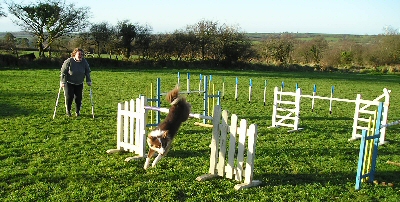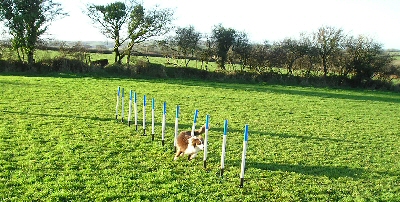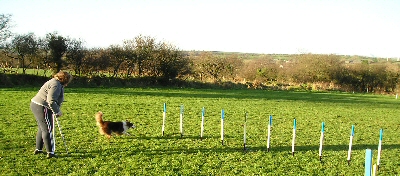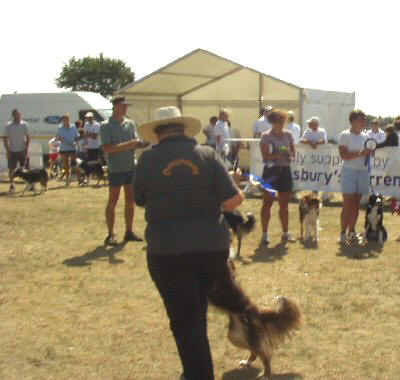Long Distance Handling
|
|
|
|
Training Tegan...
|


 |
After stars came 'snakes' and 'pull throughs' starting with two jumps and adding more as Teganís confidence grew. With snakes when we added a third jump I had to get her to turn away from me, we did this with Jo encouraging her at first then with me throwing the ball - over arm (Joís famous aeroplane arm) - over the jump. It took ages to get my timing right but we got there in the end. With 'pull throughs' we put 2 jumps side by side with a big gap between, I then sent her over a jump and called her to me through the gap using the 'through' command, as she came to me I would send her over the next jump by throwing her ball over it. Again it was all in the timing, which I frequently got wrong. As Teganís confidence grew we added more jumps and I began to move further away. If she showed signs of not being happy with the distance then I moved nearer. Once she was happy with the distance we then put the jumps closer.
I learnt early on that Tegan needed to be 'tricked' into thinking I was going with her. I do this by making sure my body always faces the way I want her to go and not turning away till she is committed to the obstacle. Early on this went wrong many times Ė and still does when I get my timing wrong. To help get the timing right we did an exercise where we put two straight rows of three jumps side by side with a bent pipe tunnel at the end.
With Jo encouraging her, I started off by sending her over one jump, into the tunnel and up the other line of three. I slowly moved back till she was happy going down one line, into the tunnel and up the other line. Once she was doing this without Jo I found I could send her down to the tunnel and could step to the end of the other line and pick her up. If I moved before she was committed to the tunnel she would pull off.
Tunnels
The flat tunnel was a different matter. She would go on beautifully if I was at the
end of it to send her on but sending her into it and then trying to get her to 'go on' on her
own just wasnít happening, until I learnt to shut up! (Difficult for me I know). It took ages
before I realised that the reason she kept coming to me after the flat tunnel was because,
although she could hear me, she couldnít make out what I was saying. Giving her the 'go on'
command as she is going into the mouth of the tunnel (and shutting up whilst she is in it)
seems to work, but only if I get my timing right and, yes, it still goes wrong from time to
time.

Directionals
We had already worked on directional commands when doing 'snakes' but boxes are also
great for teaching them, and for teaching 'go rounds'. By the time we had got to box work Tegan
was happy to work to the ball or sausage and didnít need Jo to encourage her Ė although Jo
stayed around to make sure I was doing it right (and woe betide me if I wasnít!). We only
worked on one direction at a time so as not to confuse her (Tegan not Jo). I put the ball
beyond the right hand jump and, going with her to begin with, sent her over the first jump and
gave her the 'right' command whilst turning my body towards the right hand jump. As we had
already worked on directions she quickly picked up what I wanted and it wasnít long before I
could send her ahead of me and turn her 'right'. We then did the same with 'lefts'. Going
straight on over the box was, and still is, the most difficult. She has too many choices!! It
was whilst training boxes with Sage that I realised that if I gave Sage a 'go on' command as
she was taking the first jump she would go on beautifully as long as I didnít say anything else
- (Iím afraid I canít take the credit as it was actually Iain Fraser that noticed it). I tried
it with Tegan and it worked! Not always, but more often than not, again itís timing.
To teach Tegan the 'go round' command, whilst a the same time teaching her to turn away from me, I started off in the middle of the box, tennis ball in my right hand and Tegan on my left. I then sent her over the jump whilst at the same time throwing the ball to the left and giving a 'left' command, as we had already done this when doing 'snakes' she picked this up quickly. Once she was happy doing this I then would her over a jump, turn her right, throw the ball and turn her left after it. When she was happy doing that we did it the other way. To get her to 'go round' to the next jump in the box I put the wings touching, then with Tegan, myself and the ball in the middle I sent her over a jump, turned her left (or right) and, with exaggerated body language, gave her a 'go round' command. She wanted the ball and, with the jumps on low, the only way she could get to it was by going over the next jump. It took quite a while, but as her confidence grew I could move the box out and eventually move myself outside the box. One word of warning! Be sure what commands you want to use. To this day if I say 'go round' she does it beautifully. If I just say 'round' Ė forget it!
Contacts
With Tegan now happy working away with jumps and tunnels, we went onto the contacts. We
basically did the same as with the jumps, staying close and slowly moving further away.
Sometimes I would send her on and Jo would encourage her to the end, making sure she got the
contact. I would be moving but not with her, and gradually I moved further and further away
until she was doing it without me. Other times Jo would send her on and I would be at the other
end, starting off near the contact but gradually, with Joís help, coming in to meet her from
further and further away. When she was happy working the contacts without me, we then did it
all again without Jo! Contacts were done one at a time without any other equipment, which we
introduced a bit at a time.

Weaves
Then came the weaves! As with everything else Tegan could already weave but doing
them on her own was a different matter. We did the weaves, on their own to begin with, starting
off close and gradually moving away. They took ages because every angle had to be done
separately and then they all had to be gone over again with a jump, then a tunnel, then
contacts. It was well worth the effort though.
Sometime it was frustrating because I knew she could do it, say after a jump, but then didnít seem to understand when contacts were introduced. I remember telling her off once, not sure exactly what for, but I know it put our training back a couple of weeks. After that, whenever I felt frustrated I would do something with her that I knew she could do well, praise her and forget about training for that day. I still do this either in training or when competing. If it goes wrong in the ring I look for something easy for her to finish with, that way I can keep her confidence up with praise. This type of training teaches a dog to think for itself, with a bit of guidance from itís owner, nagging doesnít work, praise does.

Training this way does take longer
Not only are you teaching the equipment but you are also trying to give the dog
enough confidence to do it on itís own. I learnt not to be afraid of taking several steps back
in order to move forwards. You need bags of patience and a sense of humour helps! You and your
dog have to have confidence in each other for it to work. This will happen only if you donít
expect too much too soon. Body language plays a large part and early on you need to exaggerate
every move Ė hence the sense of humour!
I am now training Katz. She is 16 months old and is nothing like Tegan. She has more confidence and, although she does like to please me, is not so much of a mummyís girl. Moving house, and my accident, means we are not as far along in our training as I would have liked. She is ragger and sausage mad and, unlike Tegan, knew her directional commands before she went anywhere near any equipment. She can do all the equipment, except weaves, and is confident doing them without me being close to her.
We havenít got to the stage of putting things together yet, and we havenít a clue what those contact bits on the end are for, but hopefully that will come when I can get back to training her. Teaching her has been easier as she has fewer hang ups and knows no other way.
Tegan took longer as she had to be re-trained. There is no doubt that the effort was worth it. I love her to bits Ė she is such an honest dog and my star girl. We may not set the Agility world alight but I always come out of the ring knowing that, whatever has happened, E or clear, she has given me 110% and well deserves her jump into my arms for a cuddle.
Thank you
Very many thanks Jo Fraser who played such a large part in our training. The
partnership is ours, but I wouldnít have had a clue where to start without her help.
 About
the author...
About
the author...
Chris Kurzfeld has owned dogs all her life but
didn't start agility, with Harvey at Wallingford DTC till 1992. She became agility rep, trainer
and show secretary for the club until she moved in 1999.
This move took her nearer to friends Jo and Iain Fraser where she joined Crazymaesy Agility and began training with and for them.
In 2000 Chris started her judging career and has been judging at various levels since.
Her move to Wales in 2004, with husband Andy, seven dogs and one cat, took her to an area where there are no clubs close by but, having a paddock and her own equipment, Chris is developing a new circle of agility friends.
From
Joan Hart...
I enjoyed your article on Long Distance Handling.
As a club with a few 'older' handlers and the no so fit I was wondering if I could print of &
distribute around the club? (02/02/05)
Editors note: Yes, of course.
|
[bottom.htm] © Copyright Agilitynet |